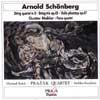Mahler; Schoenberg Chamber Works
Works from the beginning and end of Schoenberg’s career with an intriguing coupling of Mahler’s Piano Quartet
View record and artist detailsRecord and Artist Details
Composer or Director: Arnold Schoenberg, Gustav Mahler
Genre:
Chamber
Label: Praga Digitals
Magazine Review Date: 11/2002
Media Format: CD or Download
Media Runtime: 63
Mastering:
Stereo
DDD
Catalogue Number: PRD250 168

Tracks:
| Composition | Artist Credit |
|---|---|
| Quartet |
Gustav Mahler, Composer
Gustav Mahler, Composer Josef Kluson, Viola Michal Kanka, Cello Sachiko Kayahara, Piano Vlastimil Holek, Violin |
| String Quartet |
Arnold Schoenberg, Composer
Arnold Schoenberg, Composer Prazák Qt |
| String Trio |
Arnold Schoenberg, Composer
Arnold Schoenberg, Composer Josef Kluson, Viola Michal Kanka, Cello Vaclav Remes, Violin |
| Phantasy |
Arnold Schoenberg, Composer
Arnold Schoenberg, Composer Sachiko Kayahara, Piano Vlastimil Holek, Violin |
Author: kYlzrO1BaC7A
The Prazák Quartet’s prowess in the music of, and around, the Second Viennese School has already been demonstrated. This new disc ties up Schoenbergian loose ends as well as including Mahler’s sole surviving contribution to the chamber medium. His Piano Quartet movement (1876) is brooding and dark-hued; the lead-back to the main theme’s reprise is especially effective.
Schoenberg’s String Quartet in D (1897) can be interpreted either as the completion of his apprenticeship or as the harbinger of new developments. The Prazák play safe by keeping the work within the technical and temperamental limits of Brahms and Dvovák. The opening movement lacks its exposition repeat and the third movement loses some of the variations that the Arditti’s rightly include, but this is still a likeable reading – at its best in the pensive melancholy of the Intermezzo and vigour of the Finale.
In its synthesis of form and expression, the String Trio (1946) is Schoenberg’s crowning achievement. The Prazák members maintain a firm grip in the visceral ‘Part One’, and their unanimity of ensemble solves most of the textural pitfalls in which the two episodes abound. A touch more dynamism would not have gone amiss, not least the heightened reprise going into ‘Part Three’, but this remains a lucid way into a troubled masterpiece. Vlastimil Holek equally has the measure of the Phantasy (1949), projecting both its thorny rhetoric and distilled lyricism with a sure awareness of overall cohesion.
The recorded balance is immediate but sympathetic, with that between piano and strings exemplary in both respects. The notes are informative if at times prolix, and slightly awkwardly translated (‘post-Lisztian “magic rondo”’ indeed!). Altogether a worthwhile collection of – and no mean entrée into – the chronological limits of Viennese modernism.
Schoenberg’s String Quartet in D (1897) can be interpreted either as the completion of his apprenticeship or as the harbinger of new developments. The Prazák play safe by keeping the work within the technical and temperamental limits of Brahms and Dvovák. The opening movement lacks its exposition repeat and the third movement loses some of the variations that the Arditti’s rightly include, but this is still a likeable reading – at its best in the pensive melancholy of the Intermezzo and vigour of the Finale.
In its synthesis of form and expression, the String Trio (1946) is Schoenberg’s crowning achievement. The Prazák members maintain a firm grip in the visceral ‘Part One’, and their unanimity of ensemble solves most of the textural pitfalls in which the two episodes abound. A touch more dynamism would not have gone amiss, not least the heightened reprise going into ‘Part Three’, but this remains a lucid way into a troubled masterpiece. Vlastimil Holek equally has the measure of the Phantasy (1949), projecting both its thorny rhetoric and distilled lyricism with a sure awareness of overall cohesion.
The recorded balance is immediate but sympathetic, with that between piano and strings exemplary in both respects. The notes are informative if at times prolix, and slightly awkwardly translated (‘post-Lisztian “magic rondo”’ indeed!). Altogether a worthwhile collection of – and no mean entrée into – the chronological limits of Viennese modernism.
Discover the world's largest classical music catalogue with Presto Music.

Gramophone Digital Club
- Digital Edition
- Digital Archive
- Reviews Database
- Full website access
From £8.75 / month
Subscribe
Gramophone Full Club
- Print Edition
- Digital Edition
- Digital Archive
- Reviews Database
- Full website access
From £11.00 / month
Subscribe
If you are a library, university or other organisation that would be interested in an institutional subscription to Gramophone please click here for further information.




